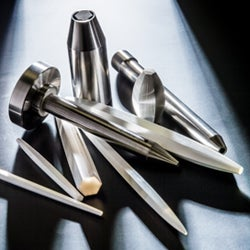- Analyzers
- Optics & Sources
- Technologies
- Support
- About
Enhancing Research Performance Through Customized X-ray Energy Optimization
Dr. Ning Gao
Enhancing Research Performance Through Customized X-ray Energy Optimization
Dr. Ning Gao
Dr. Ning Gao
Polycapillary X-ray optics bring advanced precision and efficiency to modern X-ray analysis systems used in research, industry, and medicine. By focusing or collimating X-rays from a source, these optics unlock remarkable capabilities for elemental mapping, thickness measurements, and micro-scale material analysis.
However, the effectiveness of polycapillary optics isn’t constant across all X-ray energy levels. Understanding how energy impacts focal spot size, divergence angles, and focal lengths is crucial for optimizing their performance in diverse applications. This paper explores these nuances, with expert insights on choosing the right configurations to bring out the best of your polycapillary optics.

Polycapillary optics are innovative devices that include tightly bundled hollow glass capillaries. These capillaries guide X-rays through multiple total external reflections, redirecting and concentrating them into highly intense spots or beams. Compared to traditional pinhole collimators, polycapillary optics offer up to 10,000 times higher X-ray flux density, making them invaluable in fields like microelectronics, semiconductors, pharmaceuticals, and material sciences.
Key Applications of Polycapillary Optics Include:
But these performance benefits depend heavily on the energy level of the X-rays and how well they are paired with optics.
Several performance factors in polycapillary optics vary with changes in X-ray energy. Here's how energy levels impact key parameters like efficiency, focal spot size, divergence angles, and focal lengths.
At low X-ray energies (e.g., below 10 keV), polycapillary optics deliver peak transmission efficiency, as X-rays undergo multiple external total reflections inside curved capillary channels more efficiently due to the relatively large critical angle at lower energy. Efficiency decreases progressively as energy increases beyond 30–40 keV because X-rays at higher energies have smaller critical angles and are more likely to get absorbed when hitting the surfaces of the capillaries (i.e. the incident angle exceeding the critical angle).
Practical Insight: For tasks requiring high flux density or sensitivity, like µXRF of thin layers or trace elements, prioritize low-energy applications.
The focal spot size refers to the concentrated beam's diameter at the output focal point of the optics. With higher X-ray energy, the smaller critical angle results in a smaller output focal spot size—ideal for applications demanding ultra-high resolution. At low energies, however, optics create larger focused spots due to the larger critical angle.
Use Case: A smaller focal spot size is essential for micro-scale analysis of semiconductor chips to detect single-micron defects.
Output focal length dictates the distance between the optic output and the location where the X-rays converge to a focal point. Input focal length dictates the distance between the optic input and x-ray source spot. Longer focal lengths are better for high energy optimization since these higher energy x-rays have smaller critical angles. Meanwhile, shorter input focal lengths at lower energies facilitate better performance as the shorter input length increases the optic geometric collection solid and the larger critical angle allows these x-rays to be “captured” by the optic. Output intensity increases as output focal length increases, but this results in larger spot sizes.
Quick Advice: Short focal lengths are advantageous for confined spaces in lab instrumentation or portable X-ray systems, but a shorter output focal length results in lower total output intensity.
High-energy X-rays (approximately above 30 keV) can penetrate glass capillaries and reach the focal area of a focusing polycapillary optic. These “escaped” X-rays will form a high-energy halo on the focal spot of the optic, causing the effective spot size much larger than what it is supposed to be. Special optic manufacturing processes are needed to eliminate or minimize the halo effect to make the optics work more effectively for high-energy applications.
Optimization Tip: Use polycapillary optics designed with tailored halo-reduction features to minimize halo artifacts at higher energy levels, ensuring greater precision and clarity in measurements.
Read more: Five Things to Consider When Coupling a Polycapillary X-ray Optic With an X-ray Source
A polycapillary optic captures a large solid angle of X-rays from an X-ray source and redirects them to a micron-sized focal spot or a highly collimated beam. The X-ray intensity achieved with such optics is a few orders of magnitude higher than that obtained with conventional pinhole collimators, contributing to the significantly improved X-ray analysis performance in detection sensitivity, spatial resolution, measurement speed, and precision. XOS optics are widely used in commercial instruments and customized X-ray analysis systems for various industrial and research applications in the fields such as microelectronics, semiconductor manufacturing, pharma, and life sciences.

Choosing the optimum X-ray energy range and pairing it with the right polycapillary optics design requires careful analysis. Here's a step-by-step guide to optimizing performance for your application.
Identify the parameters most critical to your application. For example:
Modern polycapillary optics come with customizable designs tailored for specific energy levels. For high-intensity needs, opt for optics with large solid input angles for maximum energy capture.
Efficiency relies on source alignment. Use stable, micro-focus X-ray sources with precise Gaussian distributions to enhance intensity at the focal spot.
Source misalignment impacts optic performance over time. Calibrate your setup periodically to maintain optimal energy flux and spot clarity.
Custom polycapillary optic designs can precisely match your energy, resolution, and application needs. Reach out to our team of experts for guidance.
X-ray energy has a profound impact on how polycapillary optics perform on key metrics, such as focal spot size, divergence angles, and transmission efficiency. By selecting the appropriate energy range and customizing your optic configurations, you can achieve unparalleled accuracy, speed, and reliability in X-ray analysis. Whether you're analyzing microelectronics or mapping elemental compositions, optimizing these parameters unlocks the full potential of polycapillary optics.
Still unsure about the best setup for your application? Talk to one of our X-ray optics experts today to discuss your requirements and get customized recommendations.

Dr. Ning Gao has over two decades of experience in advanced X-ray optics, particularly in polycapillary X-ray optics. He works closely with XOS customers, from leading OEMs (original equipment manufacturer) in material testing industry to end users from universities and national labs in pioneering research fields, to find the optimal solutions for their application needs.
As a globally recognized expert in X-ray optics and their applications, Dr. Gao is active in analytical X-ray industry community and in collaboration with top scientists on many pioneering research and development projects including the PIXL instrument on the recently launched Mars Perseverance Rover.
If you'd like to get in touch with Ning or one of our other experts, click here.

